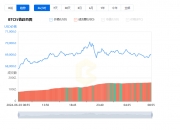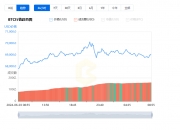
跨链(Cross-Chain)即是容许加密货币资产,跨越不同的区块链使用和保存。目前通用的区块链不止一条,除了最有名的区块链比特币和以太坊之外,各种大大小小的公链陆续冒出,当中不乏有潜力、越来越多人使用的公链,例如Solana、Avalanche、Terra、Binance Smart Chain 等等。
Cross-Chain is an encrypted monetary asset that is allowed to be used and preserved across a different block chain. At present, more than one chain of blocks is common. In addition to the most famous chain of blocks, Bitcoin and Etheria, large and small public chains emerge, with potential and increasing use of public chains, such as Solana, Avalanche, Terra, Binance Smart Chain and others.
但这些区块链是独立和互不相通的,例如在以太坊上的资产,若不使用跨链技术,就无法转移到其他区块链,如Binance Smart Chain上使用。因此,跨链技术就是为了方便不同公链资产及资讯能够互相传输。
But these block chains are independent and interconnected, for example, assets in Etheria that cannot be transferred to other blocks without the use of cross-chain technologies, such as Binance Smart Chain. Cross-chain technologies are therefore designed to facilitate the transfer of assets and information across different public chains.
就像是回到一百年前,我们不能透过A银行的凭证,去行使B银行上的存款或信用额,但自从有了VISA、银联、SWIFT等各种跨银行及国家的金融系统后,不同银行之间的资金多少能够有效互通。「跨链」正正是想办法对接不同公链的新技术。
It's like a hundred years ago, we couldn't use bank A's certificates to exercise bank B's deposits or credit, but since the creation of various cross-bank and national financial systems, such as VISA, Silver Union, SWIFT, and so on, the funds between the different banks are more or less interoperable. The "cross-link" is a new technology that seeks to connect different public chains.
跨链桥是连接各个区块链、进行资料和资产传输必备的「桥」,使得不同加密生态系统之间能够进行互动,令不同的区块链网络可以相互兼容。
Cross-linkage bridges are the "bridges" necessary to connect blocks, provide information and transfer assets, allow interaction between different encrypted ecosystems and make the network of blocks compatible.
这条「桥」不是物理意义上连接不同位置的伺服器,而是一些协议和技术,令到使用不同共识机制的区块链间,能够互相转移资料和资产,例如将位于以太坊区块链的ETH,转移到Avalanche区块链上成为wETH。
The bridge is not a server that physically connects different locations, but rather a number of protocols and technologies that allow for the transfer of information and assets between blocks using different consensus mechanisms, such as the ETH, which is located in the Etherm block chain, to become wETH in the Avalanche block chain.
当投资者在不同区块链上进行投资、质押、GameFi等等活动时,会受限于不同区块链使用各自的共识机制,无法整合资产。
When investors invest in different block chains, pledge, GameFi, etc., they are constrained by the use of their own consensus mechanisms in different block chains and the inability to consolidate assets.
若投资者需要进行资产整合或转移,就需要跨链。随着加密资产的兴起,新兴区块链生态系统的数量和规模都急剧增加,投资者未必单一使用一条区块链,跨链的需求便大大增加。
If investors need to consolidate or transfer assets, they need to cross the chain. With the emergence of encrypted assets, the number and size of emerging block chain ecosystems have increased dramatically, and investors do not necessarily use a single block chain alone, increasing cross-chain demand.
跨链技术不一定由官方发起,可以存在公链官方推出的跨链技术,也可能有第三方提供的跨链技术。以跨链技术的功能来看的话,大致分为以下五种跨链技术功能:
Cross-chain technologies are not necessarily officially initiated, they may exist in the public chain, or they may be provided by third parties. In terms of the functions of cross-chain technologies, they are broadly divided into the following five types of cross-chain technical functions:
链对链跨链桥(Chain-to-Chain Bridge)主要作用是支援两个主要区块链之间的资产转移。
The main role of the chain-to-chain cross-link bridge (Chain-to-Chain Bridge) is to support the transfer of assets between the two main blocks.
例如Polygon 官方推出的桥PoS Bridge,主要支持以太坊和Polygon 之间的跨链;Avalanche官方推出的Avalanche Bridge,主要支援Avalanche和以太坊链ERC-20 标准的跨链资产转移。
For example, PoS Bridge, a bridge officially launched by Polygon, supports mainly the cross-linkage between Ether and Polygon, and Avalanche Bridge, officially launched by Avalanche, supports mainly the transfer of assets across the chain standard of Avalanche and Ether's chain of ERC-20.
多链桥(Multi-Chain Bridge)能够跨多个区块链转移资产,可以被应用到任何Layer1 或Layer2 区块链上。
Multi-chain bridges (Multi-Chain Bridge) are capable of transferring assets across multiple block chains and can be applied to any Layer1 or Layer2 block chain.
例如:cBridge,能够连接Ethereum、Polygon network、xDai chain、Binance Smart Chain、Okex Chain、Arbitrum、Avalanche、Fantom、Heco,等等超过9 条大型区块链。
For example, cBridge can connect more than nine large block chains such as Etherum, Polygon Network, xDai Chain, Binance Smart Chain, Okex Chain, Arbitrum, Avalanche, Fantom, Heco, etc.
专用桥(Specialised Bridge)专注在特定的生态系统,专门支援资产在特定区域之间的转移。
Specialized Bridge focuses on specific ecosystems and specifically supports the transfer of assets between specific areas.
由于这些桥的专用性,专用桥通常可以提供更快、更便宜的跨链服务。例如Hop Protocol 的跨链桥方案是Rollup-to-Rollup 的通用资产桥,专门实现Layer 2 网络之间和以太坊主网之间的资产转移。
Because of the dedicated nature of these bridges, dedicated bridges can often provide faster and cheaper cross-linkage services. For example, Hope Protocol’s cross-linkage program is the Rollup-to-Rollup generic asset bridge, which specializes in asset transfers between the Layer 2 network and the Etheria home network.
打包资产桥(Wrapped Asset Bridge)专门用来将非原生资产转移到不同的区块链上,方法是在目标链上创建出打包资产(wrapped assets)。
The Wrapped Asset Bridge (Wrapped Asset Bridge) is specifically used to transfer non-original assets to different block chains by creating packaged assets (wrapped assets) on the target chain.
例如用以太坊上的Wrapped Bitcoin(WBTC)为例,就是由托管方持有BTC,再根据持有的BTC量,在以太坊上用ERC-20标准,铸造WBTC。
For example, Wrapped Bitcoin (WBTC) in the Taihouse is the hosting of BTC by the trustee, which, according to the amount of BTC held, forms WBTC using the ERC-20 standard in the Tai House.
数据专用桥(Data Specific Bridge)是专门为跨多个区块链传输任意数据而设计的互操作性协议,这些协议通常会成为dApps 的基础层,令dApps 能够实现跨链组合。例如Celer 的Inter-chain Message Framework 和IBC。
Data-specific bridges are interoperable protocols designed for the transfer of any data across multiple block chains. These protocols usually serve as the base layer for dapps, enabling dapps to achieve cross-chain combinations. For example, Inter-Chrain Message Framewerk and IBC at Celer.
以跨链核心技术来分类的话,目前最主要使用的跨链技术可以分为四种:
In the case of cross-chain core technologies, the most dominant current use of cross-chain technologies can be divided into four categories:
公证人机制(Notary schemes)
Notary notaries (notaries)
侧链/中继链(Sidechains / relays)
Sidelinks/relays
哈希锁定(Hash-locking)
Hash-locking
分布式私钥控制(Distributed private key control)
Distributed private key control (distributed private key control)
目前的跨链项目,大多使用上述这四种技术做为合约底层的基础技术,以下将简单介绍这四种技术以及各自的跨链方式。
Most of the current cross-chain projects use these four technologies as basic technologies at the bottom of the contract, which are briefly described below, as well as their respective cross-chain approaches.
公证人机制(Notary schemes)是通过寻找一个公正独立的第三方来作为两条链之间的中介,由公证人来协助验证交易。
Notary notaries (notaries) act as intermediaries between the two chains by seeking an impartial and independent third party, with notaries assisting in the validation of the transaction.
公证人会负责确认资产在两条链上的状况,并且传递资讯。例如当需要将100 USDT 从以太坊转到BSC 时,公证人会确认这100 USDT 的价值,并且把这项资讯转传到BSC 上,确认BSC 上收到100 USDT。
The Notary is responsible for confirming the condition of the assets in the two chains and for transmitting information. For example, when it is necessary to transfer 100 USDTs from Etheria to BSC, the Notary recognizes the value of 100 USDTs and forwards this information to BSC, confirming that 100 USDTs are received on BSC.
第三方公证人,可以是中心化的存在,或者去中心化的节点,种类略分为以下三种:
A third-party notary, which may be a centralized presence or decentralised nodes, may be divided into the following three categories:
中心化公证人 Centralized Notaries | 选择单一节点或是中心化组织作为公证人,不过公证人一旦受到攻击或遭逢意外,就很容易停摆。 A single node or a centralised organization is chosen as a notary notary, although it is easy for a notary to stop in the event of an attack or accident. |
多重签名公证人 Multi-signature notary | 需要多位公证人,在所有公证人都完成签名、达成共识之后,才能够完成跨链,更加去中心化和安全。 A number of notaries are required to complete the cross-linking, de-centre and security after all notaries have completed their signatures and reached consensus. |
分布式签名公证人 Distributed notary for signature | 需要多位公证人的参与。机制会随机抽取部分公证人,并在公证人完成签名后加密完成私钥。这种机制涉及密码学的公私钥,所以比起多重签名公证人机制,更加复杂和安全。 The mechanism involves both public and private cryptographic keys, so it is more complex and secure than multi-signature notaries. |
侧链(Sidechains):是依附在公链旁、一条规模较小的区块链,可以将其视为公链的一个外置硬件。
Sidelinks (Sidechains): A smaller chain of blocks attached to the public chain, which can be seen as an external hardware in the public chain.
侧链能够接收并读取主链交易的资料与数据,并将透过「锚定」的方式锁定要验证的内容,并将侧链&主链上的资产双向锚定。当交易资料通过验证,主链资产将被锁定,然后在侧链上释放等额资产,原理颇像跨国的货币兑换。相反,当侧链上的资产被锁定时,主链上也会释放相对应价值的资产。资产实际上并没有被转移,而是被锁定和重新释出。
The side chain is capable of receiving and reading information and data from transactions in the primary chain and, by " anchoring" it locks the contents to be verified and anchors the assets on the side chain in both directions. When the transaction information is authenticated, the assets in the main chain are locked and then released on the side chain in the equivalent amount of assets, which is more like cross-border currency exchange. On the contrary, when assets in the side chain are locked, the assets in the main chain are also released with relative value.
中继链(relays):中继链与侧链最大的差别,在于侧链是依附在主链底下,与主链关系紧密;而中继链则是与其他公链对等、平行,并不属于任何公链。中继链则类似公证人机制与侧链结合,中继链即可连接不同公链的资料调度中心,以第三方公证人的身份,验证不同公链间的交易资料。在读取和验证公链上的资料后,中继链锁定原链上的资产,然后在目标链上释出等值资产,达成资产锚定的功能,确保两边的交易资料对得上。
Relay chains (relays): The biggest difference between the chain and the side chain is that the side chain is attached to the main chain and is closely linked to the main chain; the relay chain is parallel to the other public chain and is not part of any public chain. The relay chain is similar to that of the notary mechanism and the side chain, which links the information dispatch centre of the different public chain to verify the transaction information between the public chain as a third-party notary. After reading and authenticating the information on the public chain, the chain locks in the assets in the original chain and then releases the equivalent asset on the target chain, achieves the asset anchoring function and ensures that the transaction information on both sides is matched.
哈希锁定(Hash-locking)听起来很难懂,但实际只是在跨链的模式上,多加了一重密码学设计,以经过杂凑函数加密处理的验证机制,去处理跨链资讯对接。运作流程如下:
Hash-locking sounds difficult to understand, but it is actually only in the cross-chain mode that an extra cryptography design has been added to process cross-chain information docking by means of a authentication mechanism that is encrypted for a patchwork function. The following are the operating processes:
1. 智能合约锁定使用者在A链上的资产
1. Smart contract lock-in of user assets in chain A
2. 智能合约用随机产生的数字和杂凑函数产生一组私钥
2. Smart contracts generate a group of private keys using randomly generated numbers and amortization functions
3. 使用者于规定时间内,在B链上提供正确的私钥
3. Users provide the correct private key on the B chain within a specified time frame
4. 智能合约在B链上释放出相对应价值的资产,完成跨链。
4. Smart contracts release corresponding value assets on the B chain and complete the cross-chain.
如果交易失败,或是未能在时间内提供正确的数字,A链上锁定的资产会自动解锁,返还给使用者。
If the transaction fails or the correct number is not provided in time, the assets locked in the A chain are automatically unlocked and returned to the user.
分布式私钥(Distributed private key control)运用用智能合约,投射原链上的资产到其他不同的链上,同时产生一组控制这些资产的私钥。
Distributed private keys (distributed private key control) use smart contracts to project assets in the original chain into different chains, while creating a set of private keys to control those assets.
这份私钥会分散由不同的机构或节点保管,达成去中心化,保障资产安全。当使用者需要转移资产到另一条公链时,就可以通过这组私钥,在不同链上锁定与解锁和解锁资产。
The private key is separated by different institutions or nodes, and is decentralised and secure. When the user needs to transfer the asset to another public chain, the asset can be locked and unlocked on different chains.
至于跨链的本质技术又如何,粗略可分为以下三类转移资产的方式:
As to the nature of cross-chain techniques, the following three types of transfer of assets can be broadly distinguished:
这个方式是锁定原链上的资产,并且在目标链上重新铸造资产,例如Polygon 的PoS Bridge、Avalanche 的Avalanche Bridge (AB) 和Wrapped BTC (WBTC) 等。
This approach is to lock in the assets in the original chain and re-engineer the assets in the target chain, such as Pos Bridge of Polygon, Avalanche Avalanche Bridge (AB) and Wrapped BTC.
情况就像把你将货币A放在国家A的一个银行金库里,而获得存放认证后,就能在国家B换领同价值的货币B;当你再次需要动用货币A时,你只需要把国家B当中尚有的资金归还,就可以重新使用国家A当中对等价值的货币。
The situation is as if you put currency A in a bank vault in State A, and when you obtain a storage certificate, you can swap currency B for value; when you need to use currency A again, you simply need to return the funds that are still available in State B, and you can re-use the equivalent value currency in State A.
这个方式是销毁原链上的资产,并且在目标链上重新铸造资产,例如Hop Protocol 和Across Protocol。
This approach involves the destruction of assets in the original chain and the re-engineering of assets in the target chain, such as Hope Protocol and Across Protocol.
再以上述例子而言,就等于你先注销国家A的货币,然后在国家B再申请同等价值的货币,然后回到A国家时则相反操作。
By way of example, it would be equivalent to writing off the currency of country A first, then applying for the same value currency in country B and then going back to country A to the contrary.
至于所「原子互换」,则是更进一步,不需要像上述两种方式般销毁或是锁定,直接透过已认证的智能合约机制,转换两种资产,也就是直接以A货币,换领B货币。
As far as “atomic swaps” are concerned, they do not need to be destroyed or locked in the same way as the above-mentioned two ways, directly through a certified intellectual contract mechanism, to convert two types of assets, that is, directly in A currency for B currency.
以上就是什么是区块链跨链技术?为什么需要跨链? 跨链技术有哪些的详细内容,更多关于区块链跨链技术介绍的资料请关注脚本之家其它相关文章!
What's the block chain cross-chain technology? Why cross-chain? What's the details of the cross-chain technology and more information about the block chain cross-chain technology?
注册有任何问题请添加 微信:MVIP619 拉你进入群

打开微信扫一扫
添加客服
进入交流群


















发表评论